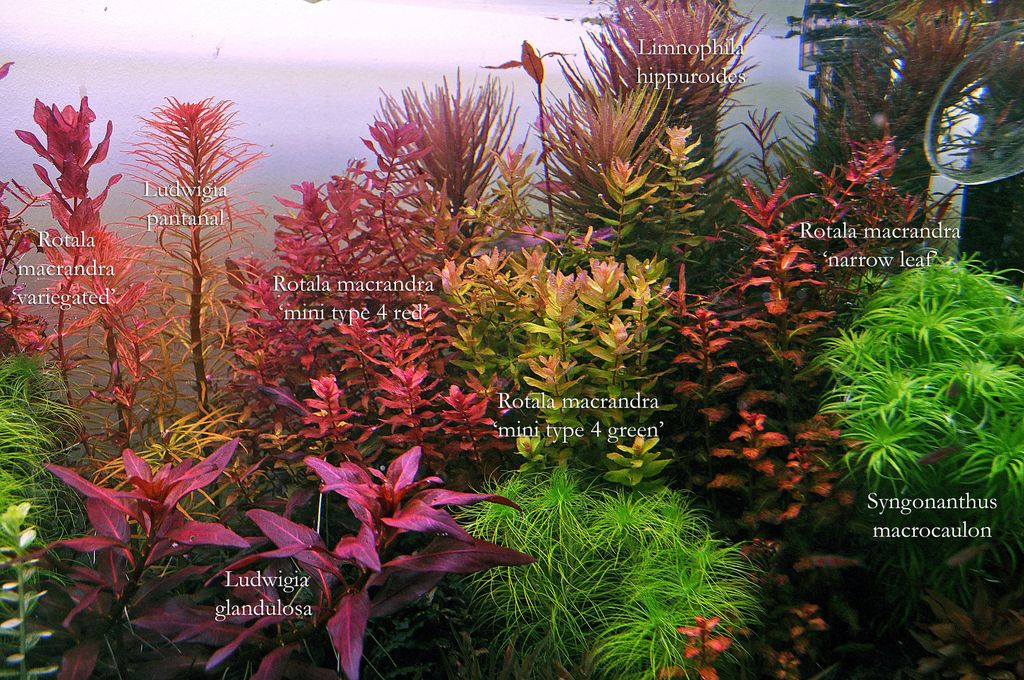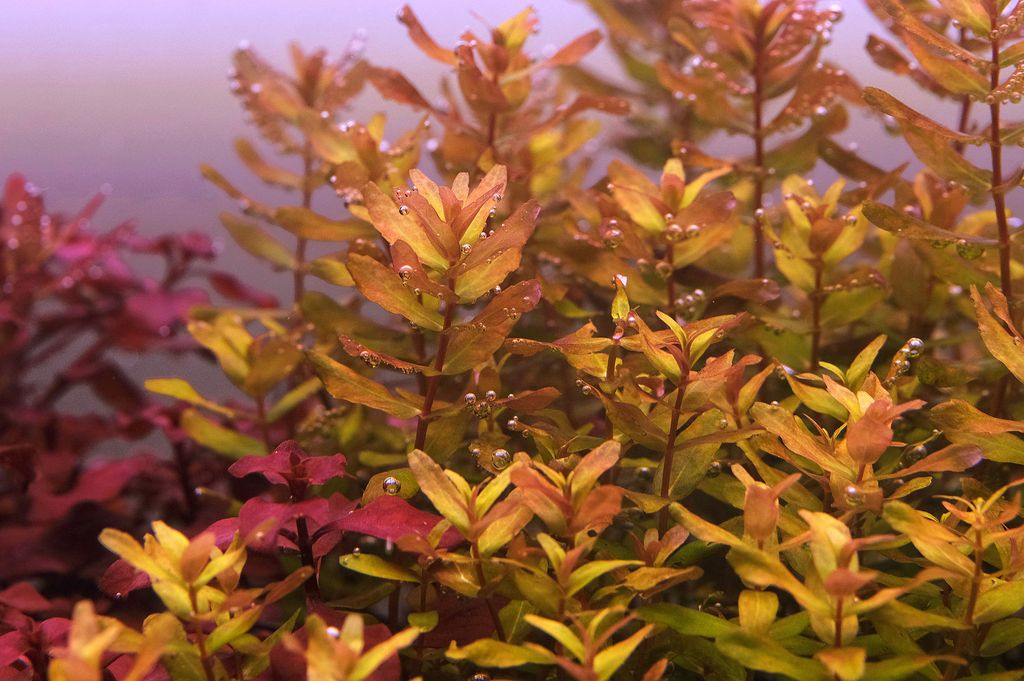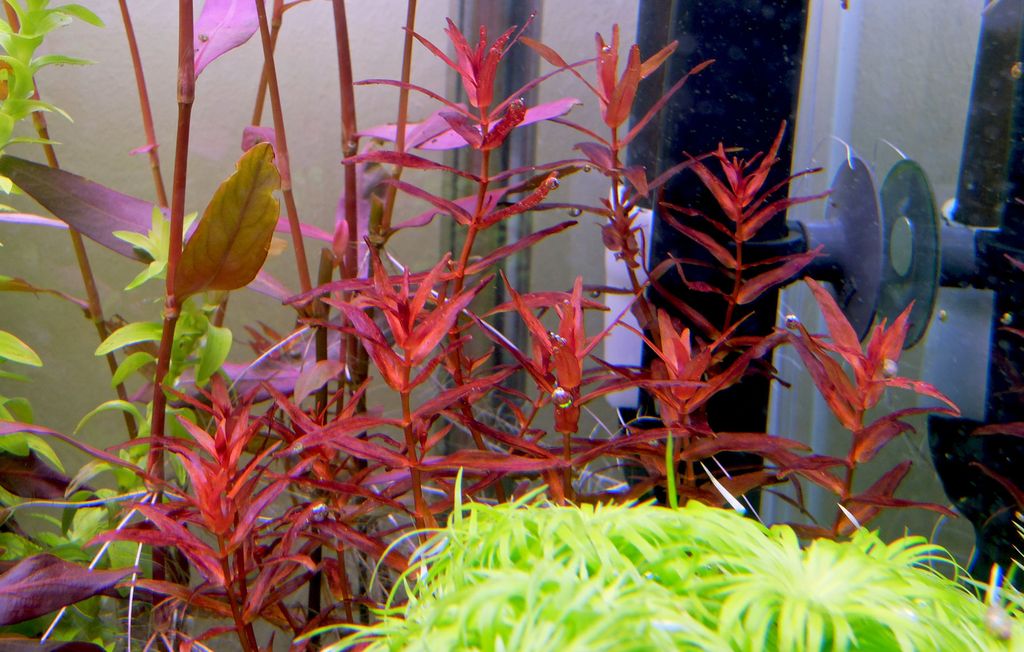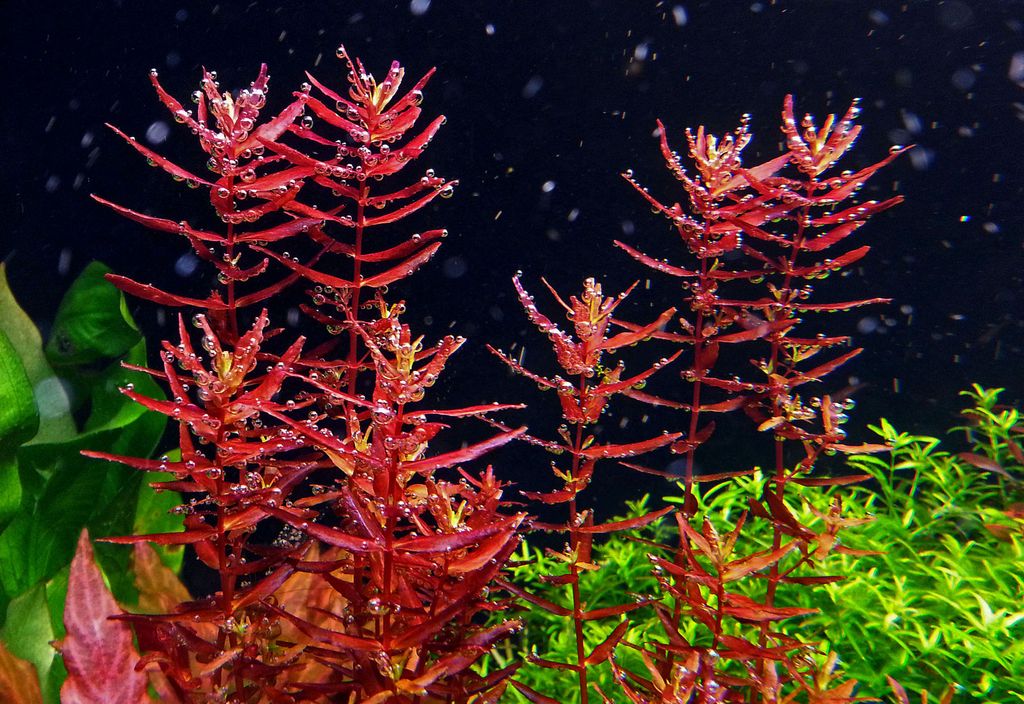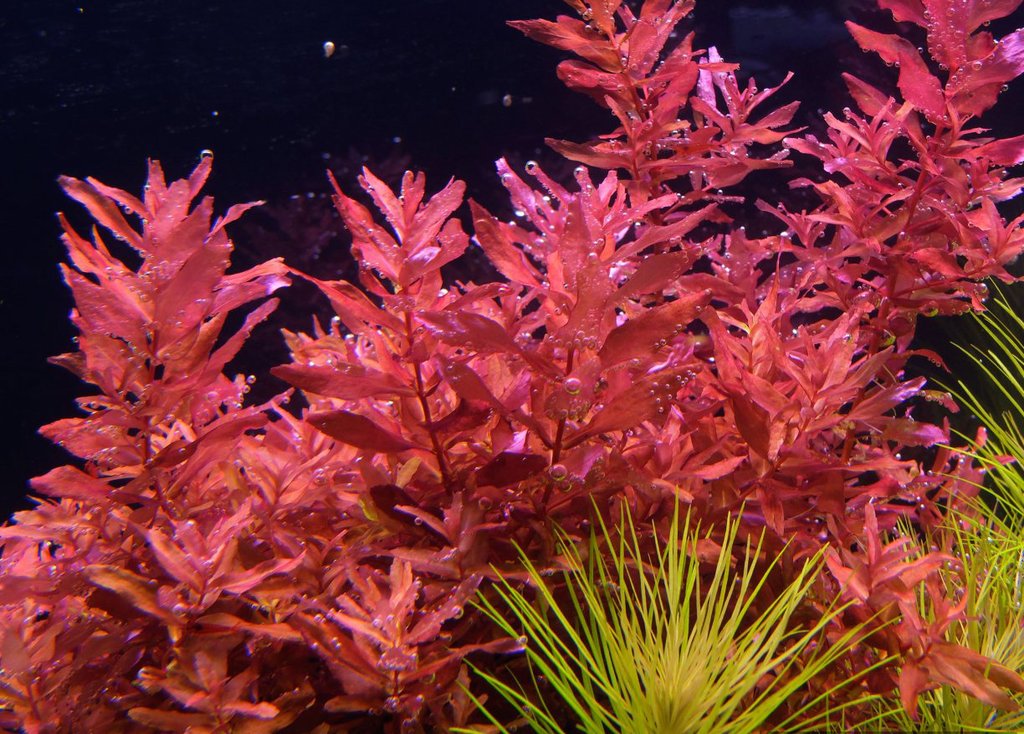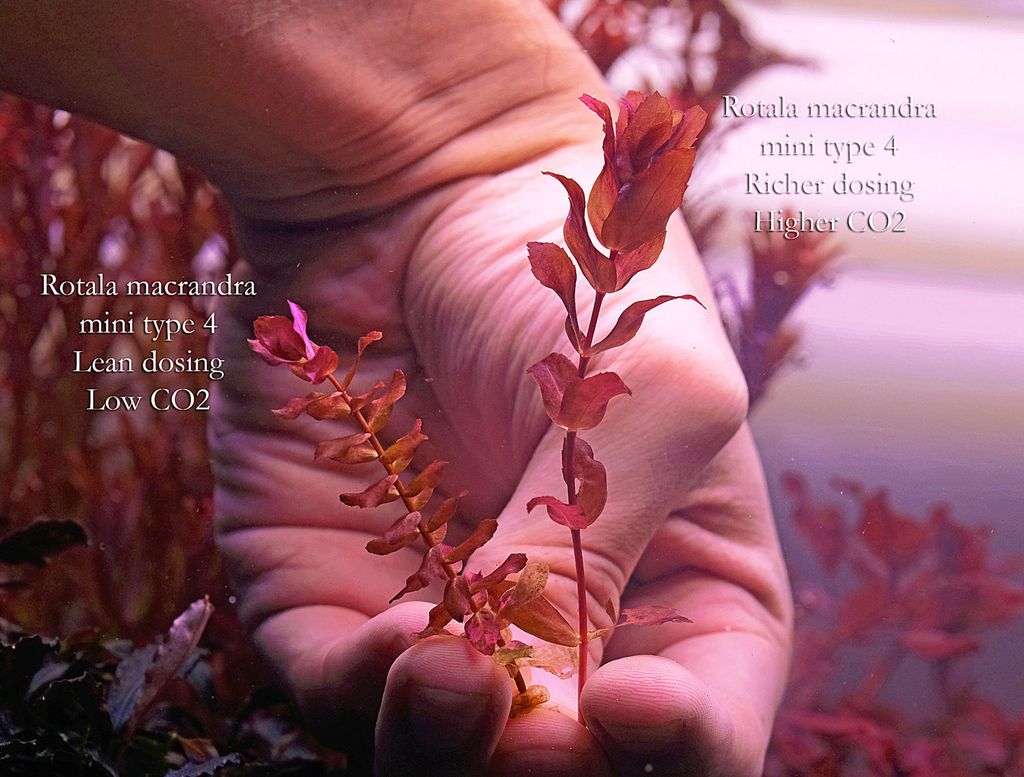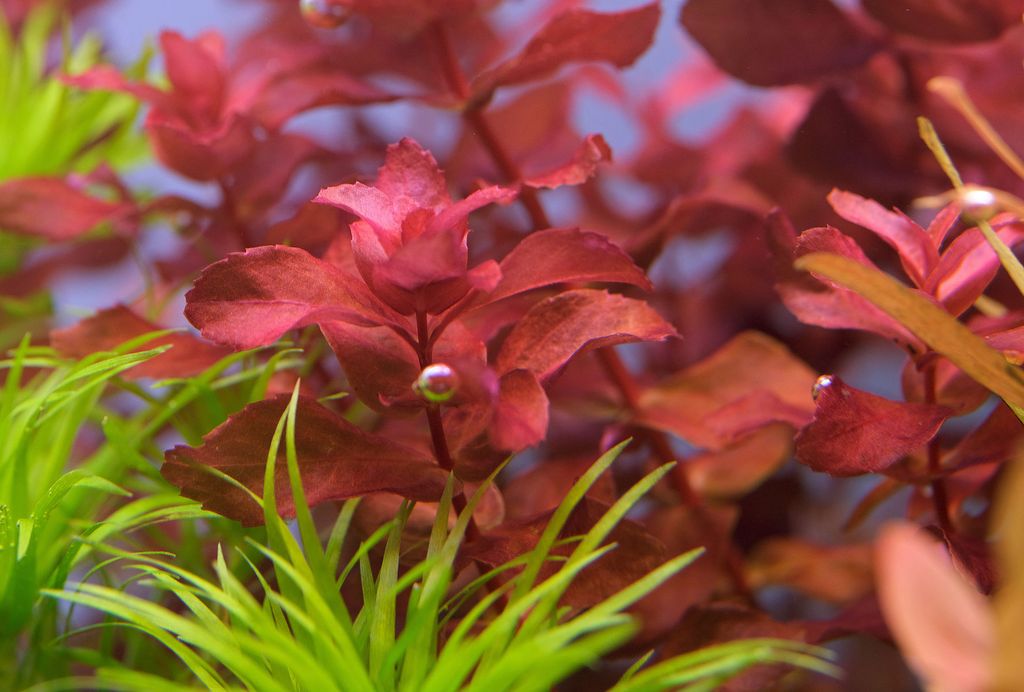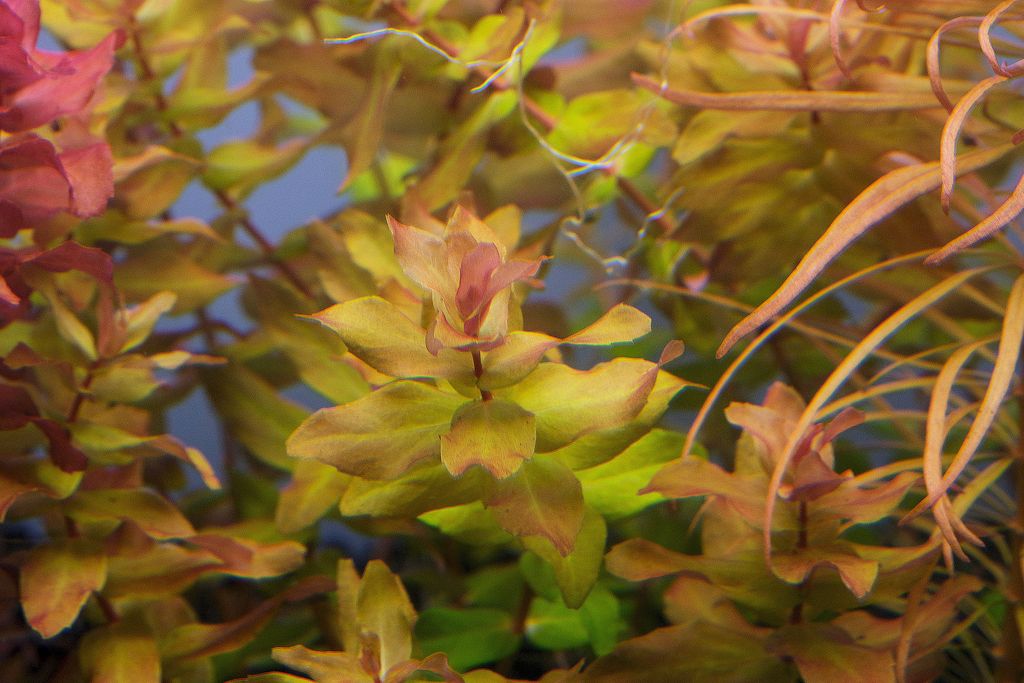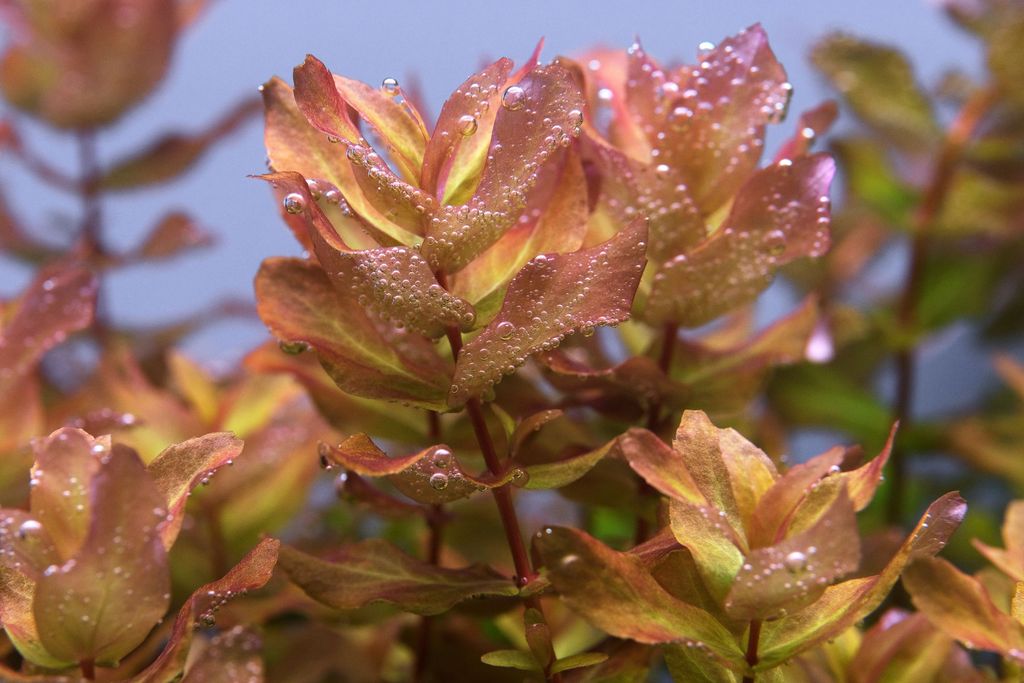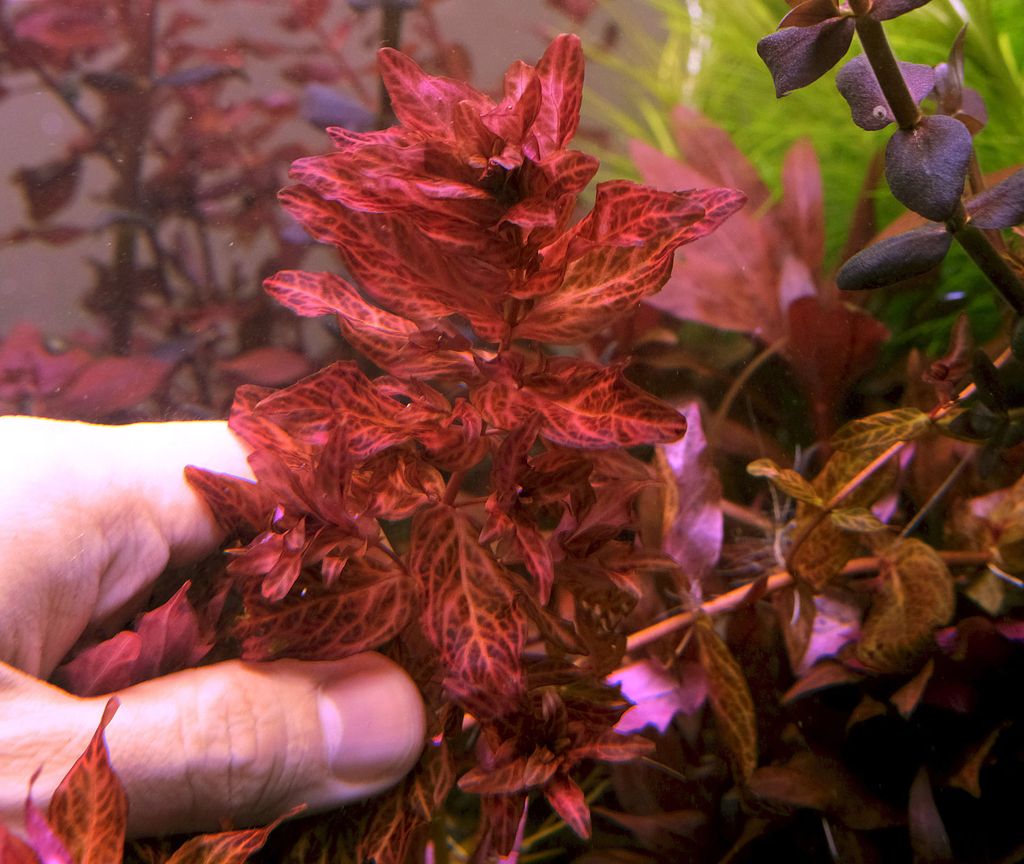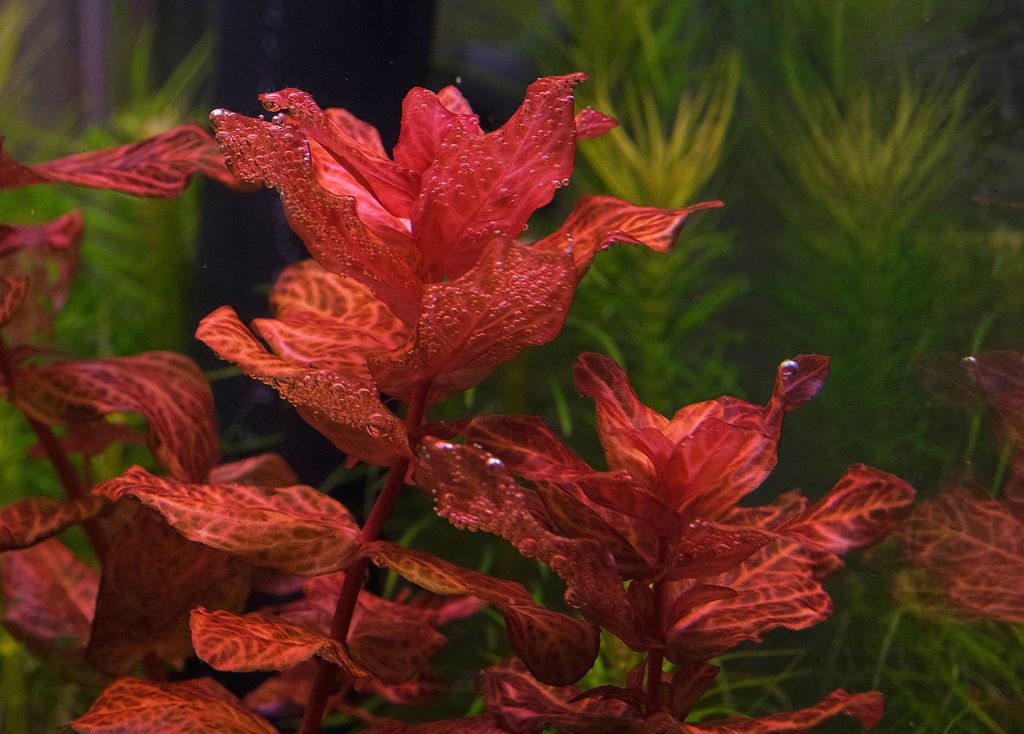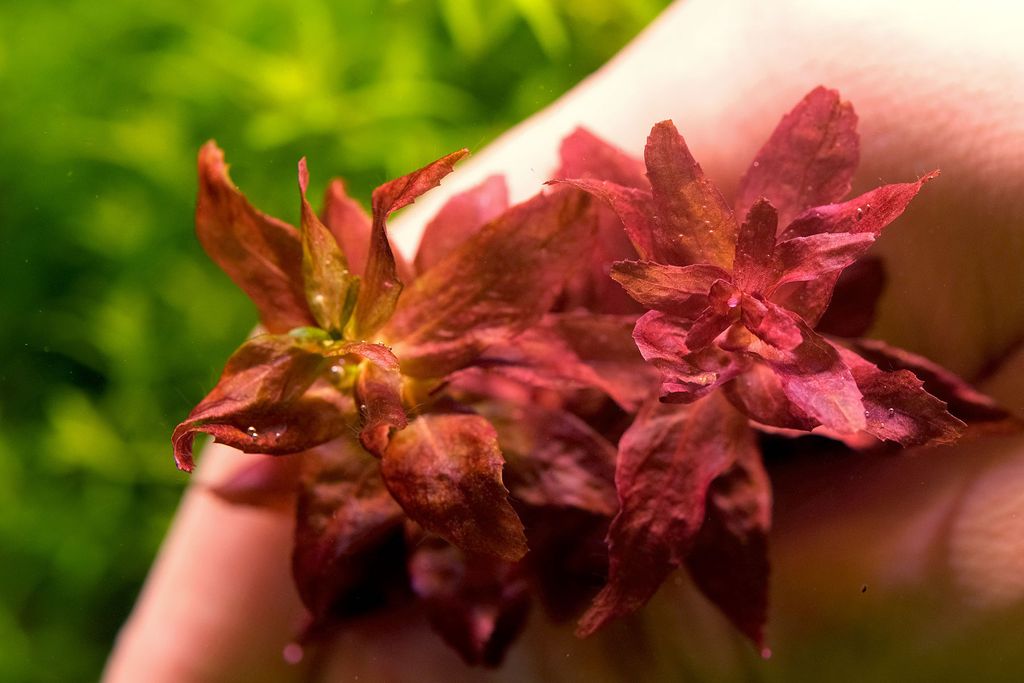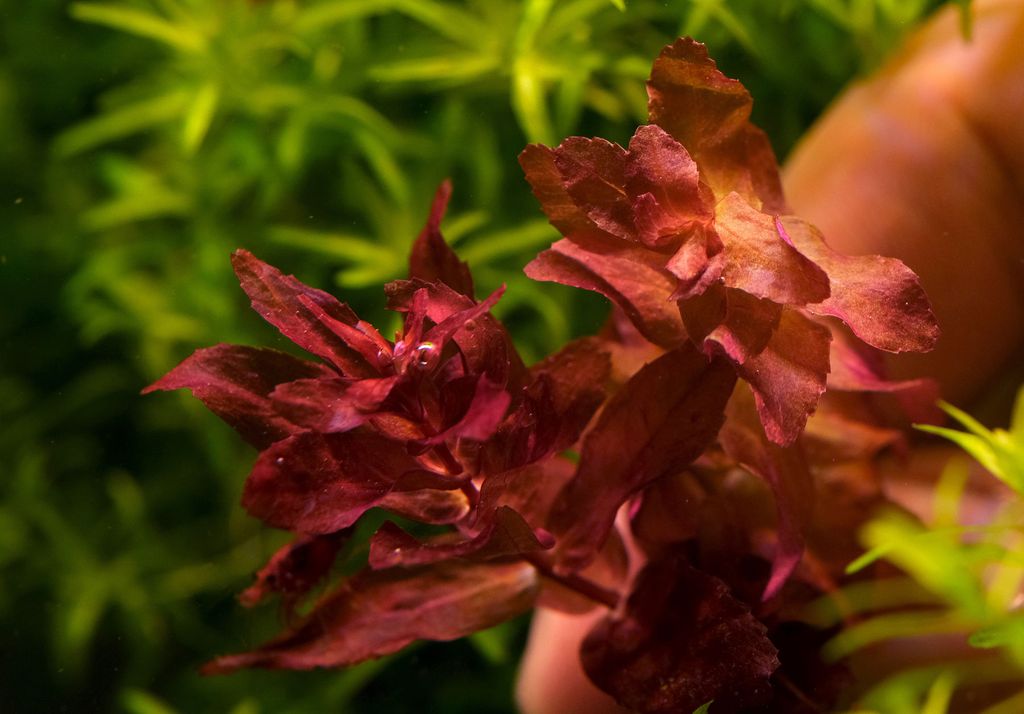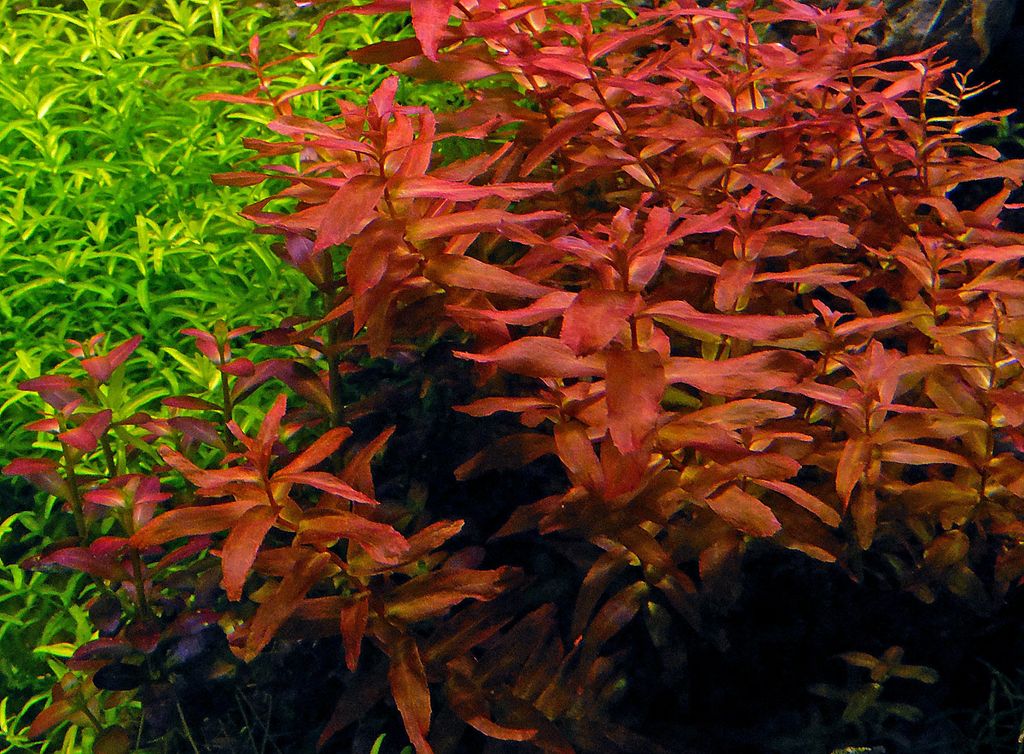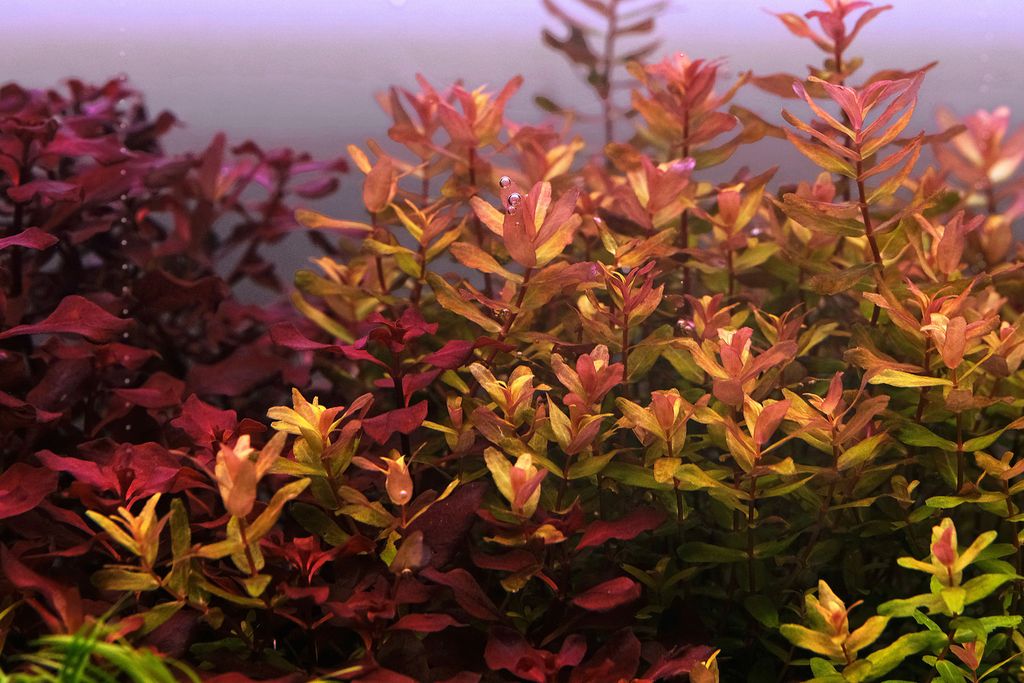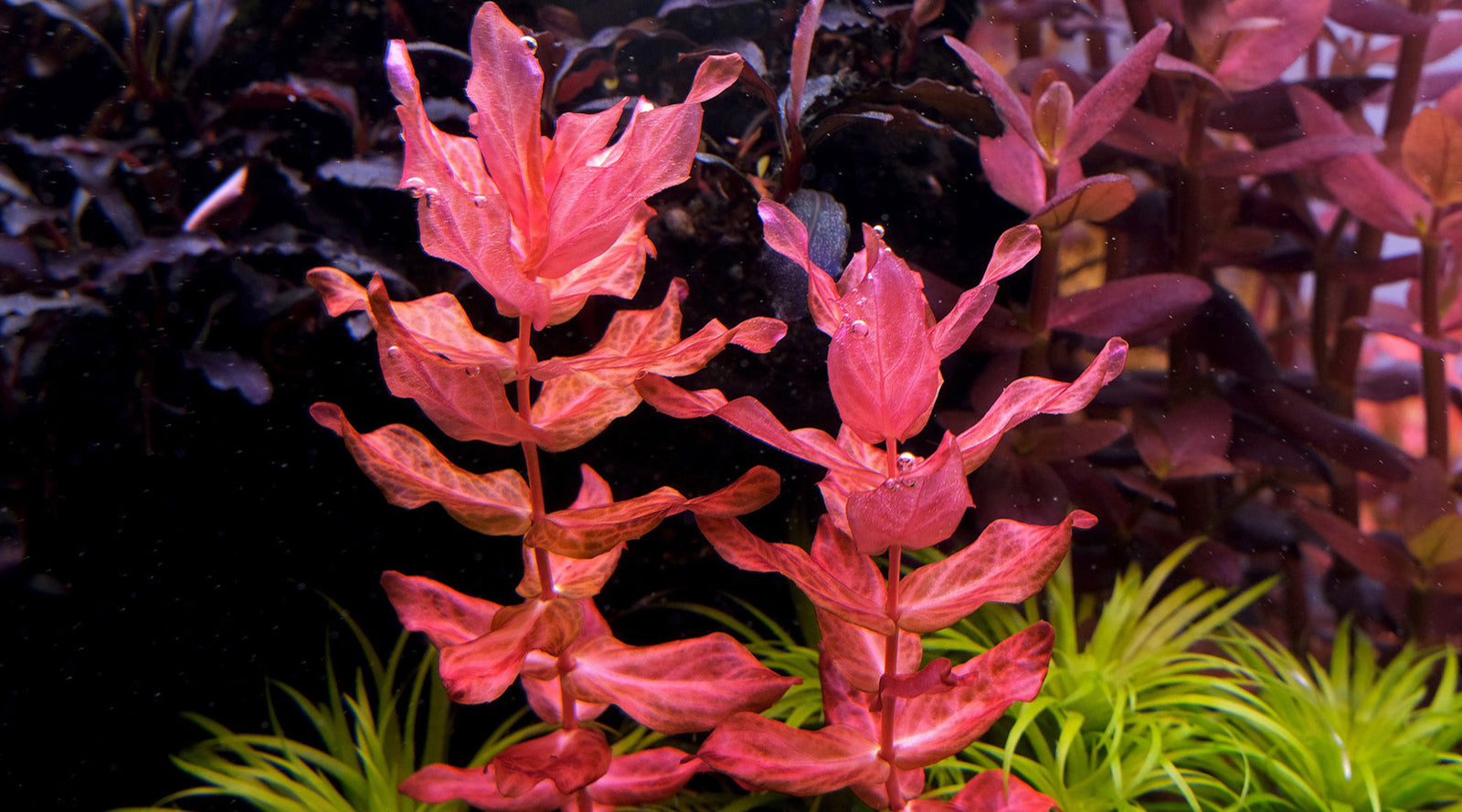
Variegated Rotala macrandra is shown above; it has a more magenta red compared to regular red Rotala macrandra with distinctive white veins. Similar size to regular Rotala macrandra, but more difficult to grow well.
Introduction
Rotala macrandra originates from India and has been cultivated in aquariums since the early days due to its attractive foliage. It is a fast growing stem plant that has the reputation of being a picky plant to grow well. Rotala macrandra has larger leaves and is pickier to grow compared to the more commonly found Rotala rotundifolia and is best used in the mid or background of a tank. Its leaves are delicate and are easily broken with rough handling. Most varietals branch readily when growth requirements are fulfilled, which allows them to become dense bushes.
There are many varietals and different morphs of Rotala macrandra. The green varietals are generally easiest to grow, the red is more difficult, and the variegated and mini versions (Including ‘mini butterfly’ and ‘mini/pearl types 1 to 4’) are significantly pickier. If we add in the ‘narrow leaf’ versions and variations from different regions, there are more than 10 distinct forms that can come under the general umbrella of Rotala macrandra.
A mix of Rotala macrandras offers a wide range of colors and leaf shapes.
Rotala macrandra ‘mini type 4’ green displays nice orange hues under high lighting. Note the serrated leaf edges. It offers good contrast to other red and green plants in the tank.
Rotala macrandra ‘narrow leaf’
Rotala macrandra ‘mini type 2’ has very unique curled leaf edges. A difficult plant to grow consistently well though.
Rotala macrandra ‘mini butterfly’ looks similar to Rotala rotundifolia red at first glance; however, it has a deeper red tone with leaf edges that are slightly rolled outwards. It takes on a more compact, rounder form under slower growth conditions.
Rotala macrandra ‘mini type 4’ red from our 2Hr farm tank, growth form is similar to regular Rotala macrandra, but it is about 1/3 the size. Substrate PAR is around 200 umols, water column fertilization is lean with rich substrate.
Growth requirements
Though there are many varietals, all of them like the same growth requirements – the more difficult varietals just stunt and grow poorly quickly if requirements are not met, while the easier varietals are more forgiving. Rotala macrandras are one of the best indicator plants in the aquarium, changing their growth forms with great variability depending on growth conditions in the tank.
Rotala macrandras grow best in soft water (low KH
Rotala macrandra does best with CO2 injection. Rotala macrandras generally do not actually require very high levels of CO2, however, they do not take CO2 fluctuations well. So CO2 levels have to be sustained at a steady level (long term) whether you choose a higher or lower injection rate. Dips or inconsistent CO2 levels easily lead to stunting of tips in the more picky varietals. Lower injection rates can give more compact and smaller growth forms, along with slower growth. There will also be less branching at low CO2 levels. Higher injection rates give larger, more robust plants – this will be more favourable to newly introduced, adapting or damaged plants. At higher CO2 levels, there will be more branching off the main stem, and significantly faster growth speed. Growing them at high speed also means that there is less room for error in fertilization – if fertilization is overly lean when light and CO2 levels are high, there will be premature deterioration of lower leaves.
Both plants were cuttings taken off the same plant and grown under different conditions. Leaner fertilization and lower CO2 gives slower growth and more compact forms while higher CO2 and fertilization levels give larger forms.
Rotala macrandra requires regular fertilization to get their best forms and coloration. Ammonia at the root zone (principally through the use of enriched aquasoils) gives a significant boost to stem thickness, leaf and crown size and overall robustness of the plant. Despite being a fast growing stem plant, Rotala macrandras do respond well to root feeding. When macro fertilization is lacking, the deterioration starts on the older leaves and lower stems. This can occur quite quickly in fast growth setups (high light, high CO2) but takes longer to occur in slow growth setups (setups that use less light, low CO2).
Micro fertilization (Fe/trace) issues tend to manifest in coloration (faded or poor coloration can indicate insufficient iron/trace) or poor micro-nutrient mixes (leaf curling excessively).
These plants are grown in substrate enriched with ammonia – which gives thicker stems and rounder, fuller leaves.
Crown and top leaves should be comparable size to lower leaves. Diminished crown size is the first hint that parameters are not optimal.
Stunting tips in Rotala macrandra
Tip stunting in Rotala macrandra ‘narrow leaf’ vs normal growth on the right. Both plants were from the same batch of plants but grown under different fertilization regimes.
Stunting tips is a common occurrence for many Rotala macrandra growers. Contrary to popular belief, tip stunting is rarely connected to a lack of macro fertilization – which manifests as poorer coloration and smaller sized plants. Rather, it is almost always connected to sudden dips in CO2 levels, or excessive water column fertilization. (or high NO3 levels due to livestock). Too lean macros long term leads to deterioration of lower leaves first, not tips. Higher macro fertilization works in soft-water (3
All samples below are from the same genetic stock/mother plant but grown in different soft-water tanks.
Tip stunting (left) vs normal healthy growth in Rotala macrandra ‘mini type 4’.
Tip stunting due to over fertilization (left) vs overly lean fertilization (right). Note that the left sample has deeper coloration over the right sample. Overly lean fertilization can result in more faded coloration/paler leaves, and in extreme cases, pre-mature deterioration of lower leaves – it does not lead to tip stunting though. Both stems are Rotala macrandra ‘mini type 4’.
Rotala macrandra ‘mini type 4’ in optimal fertilization (left) vs slightly too lean (right). Coloration is a tad faded when conditions are lean. Coloration is also heavily dependent on light spectrum & quantity (PAR values).
As with many plants in the Lythraceae family, Rotala macrandras grow most stable with rich root fertilization and with leaner water column. Overly-rich water column fertilization (especially high NO3 levels) with harder water leads to stunting tips easily (though this can work if your water is very soft). In that sense, the harder/more alkaline your water, the more the plants should be root fed rather than water column fed. * Vin kutty’s 2019 AGA talk covers this topic extensively. The running hypothesis is that this family of plants has issues regulating nutrient uptake through their leaves, especially in harder/more alkaline water, so feeding them through their roots result in much more stable outcomes.
We use Rotala macrandras sometimes in our Seiryu (limestone) aquascapes. Rotala macrandra mini type 4 is shown above grown in 8 – 9 dKH water, with rich soil / lean water column fertilization. The form is not as full and the coloration is a tad lighter compared to plants grown in softer water, but it grows pretty steadily otherwise.
Key success factors
- Stable water parameters and stable CO2 levels (sudden dips in CO2 levels can cause tip stunting)
- Soft water/Low KH levels are very helpful (3
- Many species can be grown in more alkaline water with richer root feeding, leaner water column fertilization. (watch for tip stunting)
- Better light spectrum (stronger percentage red/blue) and higher PAR values gives better coloration for red varietals
- Slower growth parameters, higher light values give shorter inter-nodes
- Avoid shading
Trimming & propagation
Rotala macrandra is a fast growing stem plant so propagation is easy; cut off top 3 to 4 inches of the stem and replant, leave the bottom portion to sprout new shoots. Robust varietals such as the green varietals can take more topping cycles before requiring replanting of new tips and discarding of old bottoms.
Rotala macrandra ‘mini type 4’ green, beside Ludwigia ‘super red’.
